Physical Address
304 North Cardinal St.
Dorchester Center, MA 02124
Walter Dandy at the Johns Hopkins Hospital was the first to describe an aneurysm clipping. In 1938 a patient presented to him with complete palsy of the third cranial nerve along with periorbital headaches. Through clip application, Dandy achieved complete obliteration of the neck of the posterior communicating artery (PComA) aneurysm while preserving the parent vessel. Seven months following the procedure, the patient experienced full resolution of his third nerve palsy and had an uneventful recovery. ,
Intradural aneurysms of the supraclinoid segment of the internal carotid artery (ICA) are classically associated with either PComA and anterior choroidal artery (AChA) branches or with the bifurcation of the ICA terminus that gives rise to the anterior cerebral artery (ACA) and middle cerebral artery (MCA). Infrequently, anterior and posterior wall ICA aneurysms may occur. These refer to supraclinoid ICA aneurysms with no associated branch vessels that arise directly from the wall of the ICA. Aneurysms occurring in these locations possess distinct features that require precise consideration with respect to surgical management.
Comprising approximately 25% of intracranial aneurysms, PComA aneurysms are the second most common after aneurysms of the anterior communicating artery (AComA). Approximately 4% to 15% of intracranial aneurysms are located at the ICA bifurcation; rarer still are those that occur at the AChA, which represent less than 5% of aneurysms of this variety. , The incidence of pediatric intracranial aneurysms is relatively low and ICA termination aneurysms are the most common for this patient population.
The focus of this chapter will be the surgical management of ICA aneurysms arising specifically at the aforementioned locations. The diagnosis, treatment, and planning of both unruptured aneurysms as well as those that present with subarachnoid hemorrhage (SAH) are considered in separate chapters within this volume.
The intracranial portion of the ICA has its embryonic origins at the dorsal aorta. At approximately the 28th to 30th day of development, the caudal divisions of the ICA form anastomoses with the cranial portion of the two longitudinal neural arteries. A second anastomosis occurs between the caudal divisions of the ICA and the paired neural arteries of the hindbrain. These neural arteries are basilar artery precursors that will regress to form the PComAs. The cranial division of the ICA will give rise to the AChA, ACA, and MCA at approximately 41 to 48 days into development. Regression of the carotid and basilar system anastomoses, formed through the trigeminal, otic, and hypoglossal arteries, will occur during later stages.
At 8 weeks into development, the caudal division of the ICA will continue to develop into the posterior cerebral artery (PCA) while supplying the stems of the PCAs. The PComA will regress as development of the vertebrobasilar system progresses. At this stage, communication of the PComAs posteriorly is provided by the PCAs. In approximately 20% to 30% of cases, the embryonic PComA fails to degenerate. Should this occur, the ICA by way of the fetal PCA, rather than the vertebrobasilar system, will serve as the primary blood supply to the occipital lobes. The term fetal PCA is used to describe a PComA that is equal in caliber to the P2 segment of the PCA and associated with a hypoplastic P1 segment. In this circle of Willis variant, the PCA territory derives its dominant blood supply from the fetal PCA. Accordingly, flow to this artery must not be compromised in the event of surgical clipping or coiling.
Computed tomography (CT) is the standard primary imaging modality for diagnoses in patients who present acutely with suspicion of SAH. In cases where suspicion of SAH is high but SAH is absent on the head CT, a lumbar puncture may be necessitated since this is a more sensitive test for SAH detection. Aneurysm diagnosis and preoperative planning can also be derived from a computed tomography angiography (CTA). Incidental, unruptured aneurysms are often diagnosed initially on CTA or magnetic resonance angiography (MRA) as these imaging studies have become widely available ( Fig. 47.1A ).
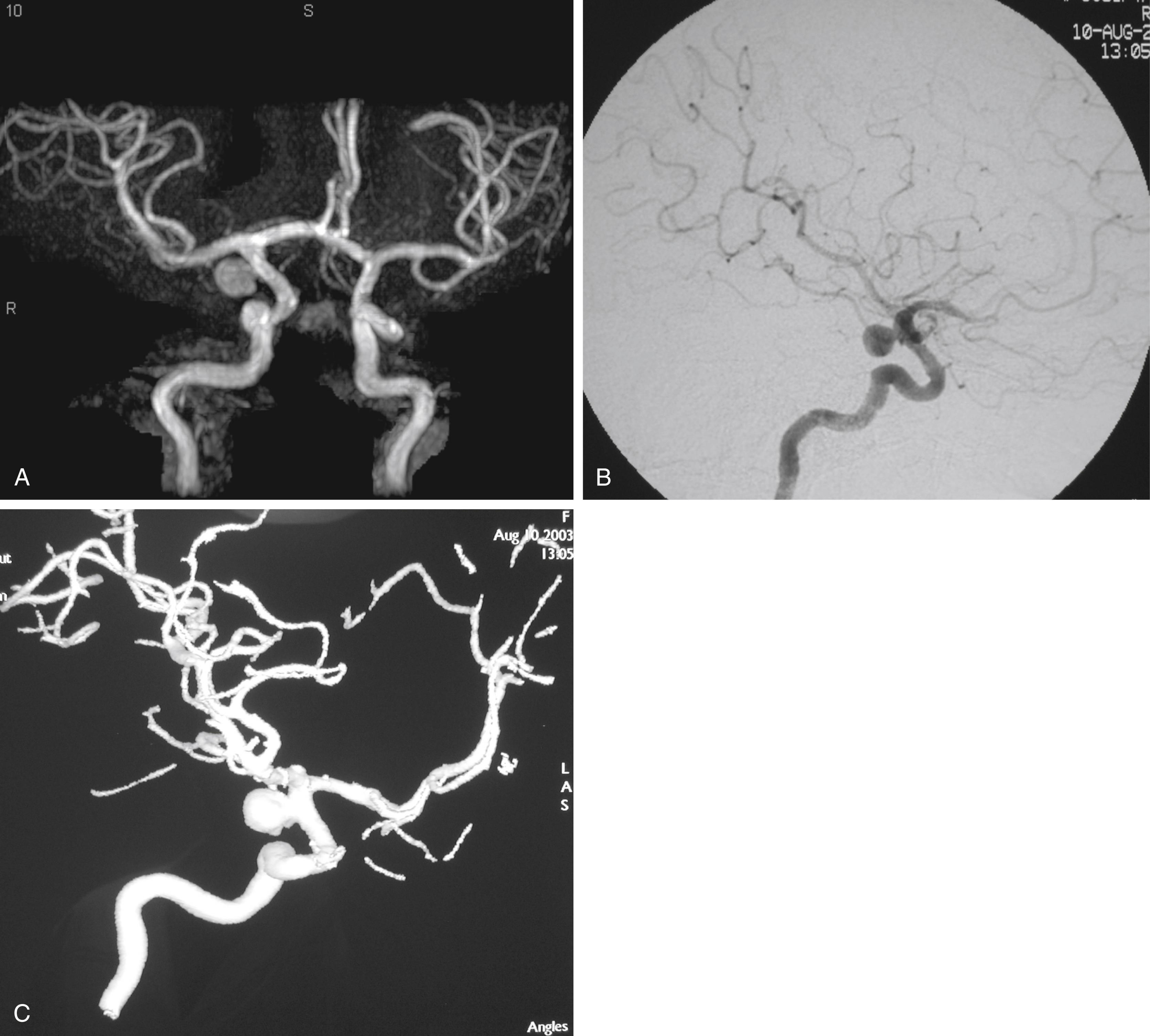
Digital subtraction angiography (DSA) continues to be the “gold standard” for the diagnosis and preoperative planning of cerebral aneurysms (see Fig. 47.1B ). The strength of the DSA lies in the ability to acquire rotational views and three-dimensional reconstructions (see Fig. 47.1C ), as well as perform selective arterial injections and cross-compression testing. For the assessment of vasculature with respect to PComA aneurysm treatment, the lack of filling of the PCA or a nonvisualized P1 segment upon vertebral artery injection ( Fig. 47.2C ) is defined as a fetal PCA (see Fig. 47.2A and Fig. 47.2B ).

When planning for the treatment of ICA bifurcation aneurysms, during the diagnostic angiogram, it is vital to use a cross-compression test to determine if the contralateral A1 provides cross-filling of the ipsilateral ACA across the AComA. To accomplish this, the ipsilateral ICA is compressed during injection of the contralateral ICA to assess whether the contralateral ICA can sufficiently supply the ipsilateral ACA territory. Observed cross-filling would suggest that the contralateral A1 can provide compensatory filling of the ipsilateral A2 via the AComA should the ipsilateral A1 be compromised during microsurgical clip reconstruction.
Patients with aneurysms located at the PComA, AChA, or ICA bifurcation most commonly present with SAH ( Fig. 47.3A ). Treatment consideration for patients who present with a SAH is conducted on an emergent basis. To minimize the chance of a rebleed, treatment should be initiated within 24 hours of presentation. Urgent treatment should also be considered for patients with symptomatic, unruptured aneurysms. Decision-making with respect to treatment of unruptured aneurysms that are found incidentally involves considering features of both the aneurysm and patient, including family history and previous instance of aneurysmal SAH. The decision to pursue microsurgical or endovascular therapy will depend on several factors. One must consider the age and medical condition of the patient; the size, location, and morphology of the aneurysm; and the experience of the surgeon.
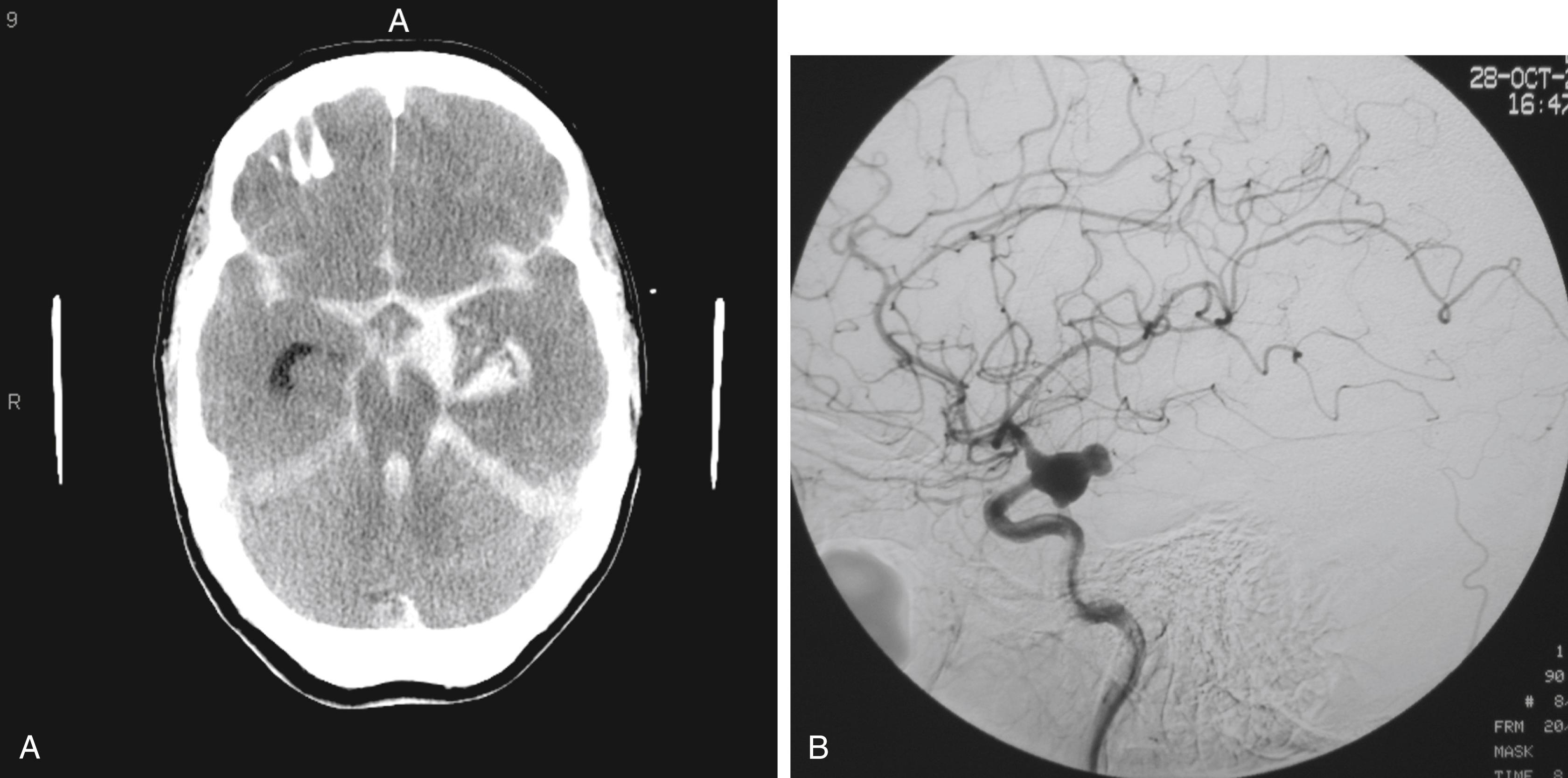
Patients may present with symptoms related to mass effect or hemorrhage in the absence of a SAH. Partial or complete, non–pupil-sparing palsy of the oculomotor nerve may be observed in patients with enlarging ruptured or unruptured PComA aneurysms. Pupil dilation occurs when the parasympathetic fibers running along the oculomotor nerve’s outer surface are mechanically compressed. Resolution of diplopia and ptosis is more frequently associated with microsurgical clip placement, due to ready relief of the aneurysmal compression, but can also be attained with coiling. In an univariate analysis, only severity of oculomotor nerve palsy during admission was significantly associated with full recovery of third nerve function post clip placement. One-hundred percent of patients with partial oculomotor nerve palsy in the study regained complete nerve function. Full recovery was only observed in 40% of those with complete oculomotor nerve palsy. No statistically significant association was found between oculomotor nerve function recovery and early intervention. Resolution of oculomotor nerve function following endovascular coiling has been demonstrated in case reports.
Patients who present with SAH due to a PComA (see Fig. 47.3B ) or AChA ( Fig. 47.4 ) aneurysm that has ruptured may also have an associated temporal intracerebral hemorrhage (ICH) or acute subdural hematoma. For these patients, craniotomy for evacuation and subsequent clipping of the aneurysm may be pursued. Rupture of an AChA aneurysm commonly manifests with intraventricular hemorrhage (IVH) and hydrocephalus. Rupture of a terminal ICA bifurcation aneurysm can present with a basal ganglia ICH, with or without an associated IVH.
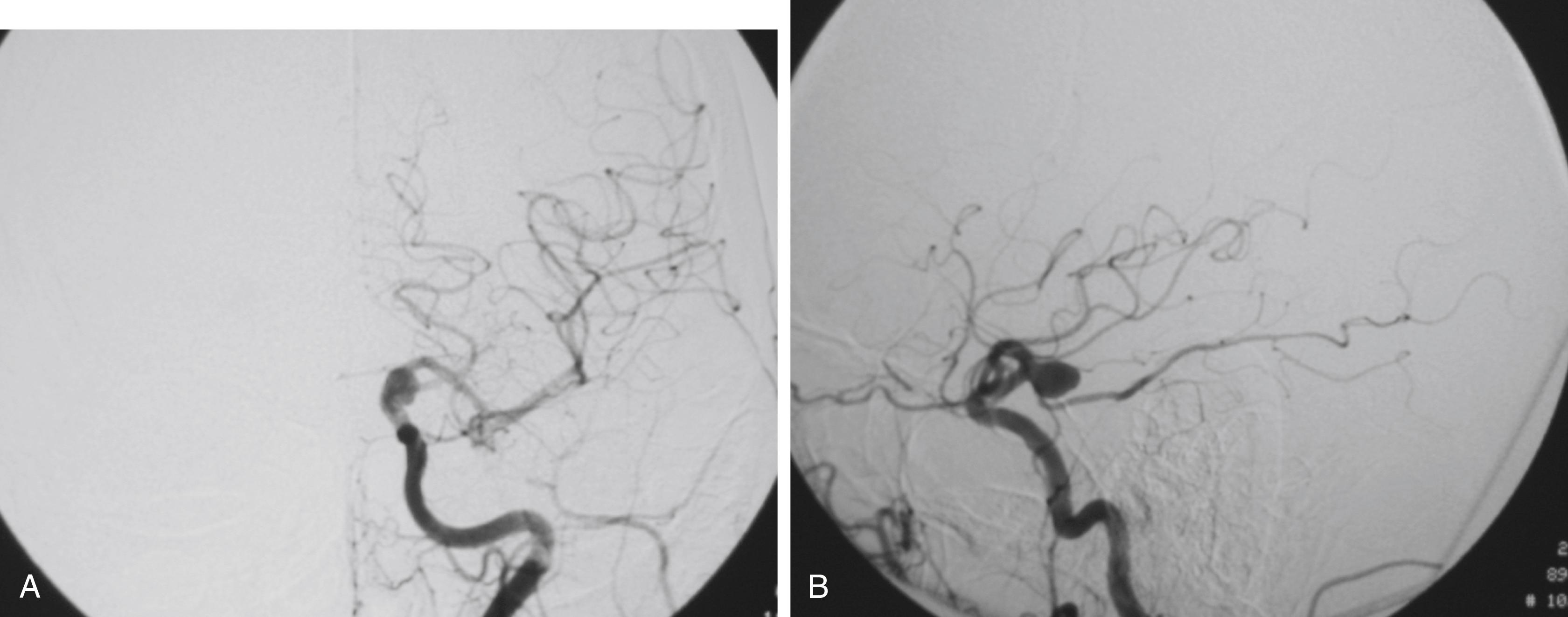
Thirty-three percent of patients present with symptoms of ischemia or stroke from aneurysm-related emboli. Ischemic events more frequently accompany anterior circulation aneurysms but can be observed in the distal vascular territory due to aneurysms of various sizes, including smaller ones.
Microsurgical clipping tends to be favorable for posterior communicating segment ( Fig. 47.5 ), anterior choroidal segment, and terminal ICA bifurcation aneurysms of the anterior circulation. Aneurysms of the posterior communicating and anterior choroidal segments are aneurysms of the carotid wall; accordingly their base often includes the origin of the branch artery ( Fig. 47.6A ). Clip application across the proximal neck of the aneurysm can be achieved, with preservation of the branch artery origin as well as minimal brain retraction, given detailed study and identification of the branch artery that the aneurysm neck is adjacent to (see Fig 47.6B–E ).
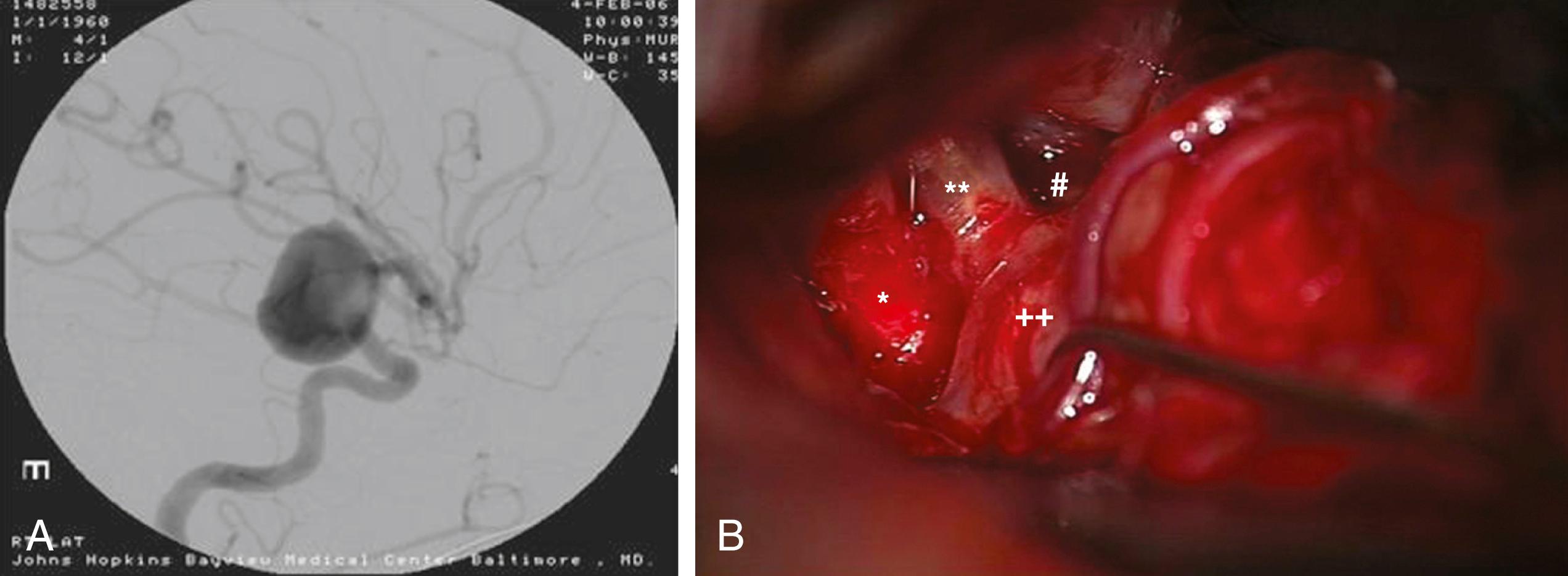
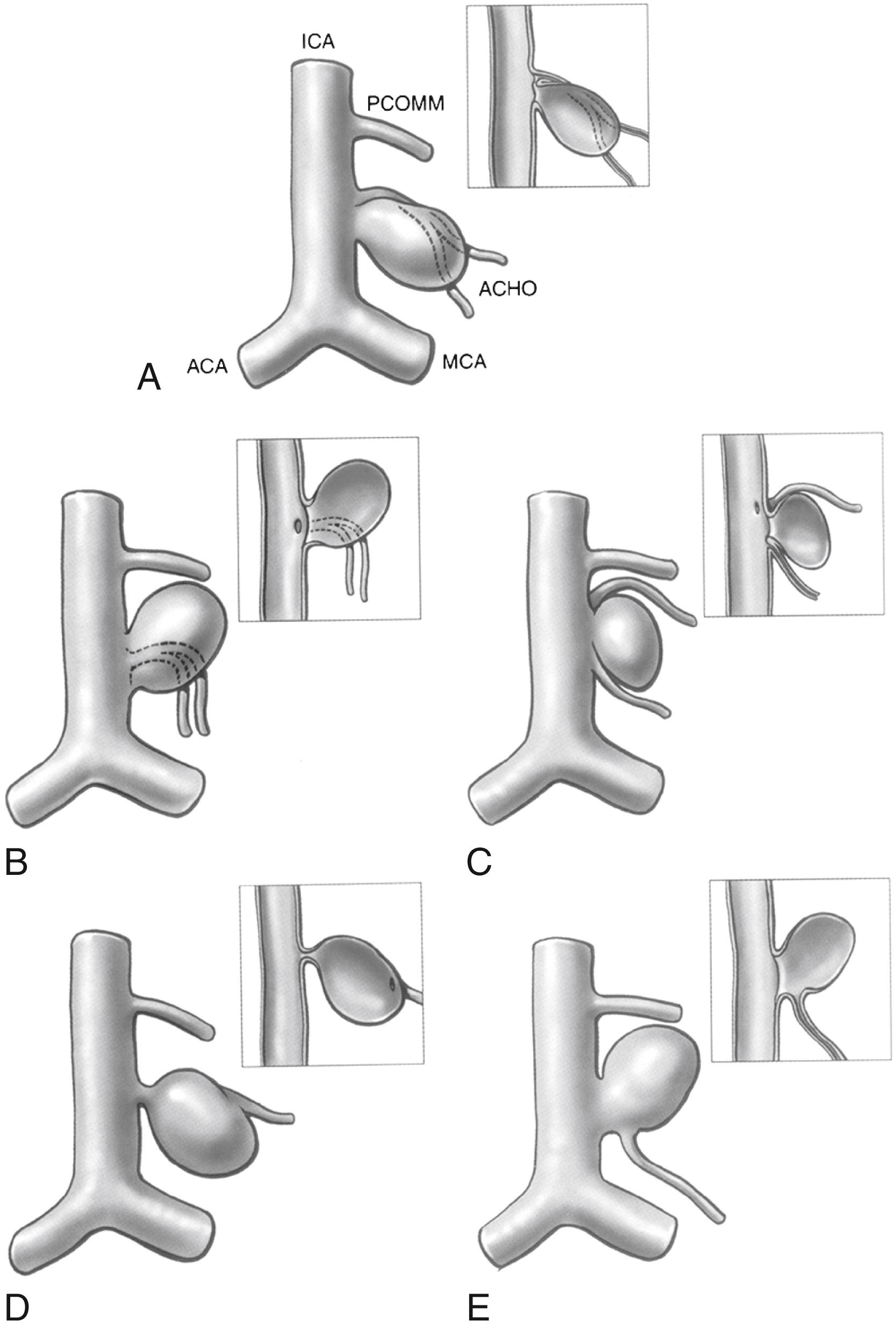
Endovascular intervention may be more favorable for ICA termination aneurysms that project posteriorly or those with walls that are heavily calcified. In the event of notable atherosclerosis and/or calcification, use of clip blades for a thick-walled aneurysm neck may result in stenosis of the proximal A1 or M1, at their origin from the bifurcation of the terminal ICA, that is hemodynamically significant. However, this can be mediated through clipping more distally on the aneurysm neck. To assess for aneurysm wall calcification during pretreatment planning, CT or CTA ( Fig. 47.7 ) can be used. Poor visualization of the perforating arteries that originate from the posterior wall of the distal ICA might render posteriorly projecting ICA termination aneurysms favorable for endovascular therapy. Inadequate visualization of these perforators poses a great risk for surgical clipping of these aneurysms.
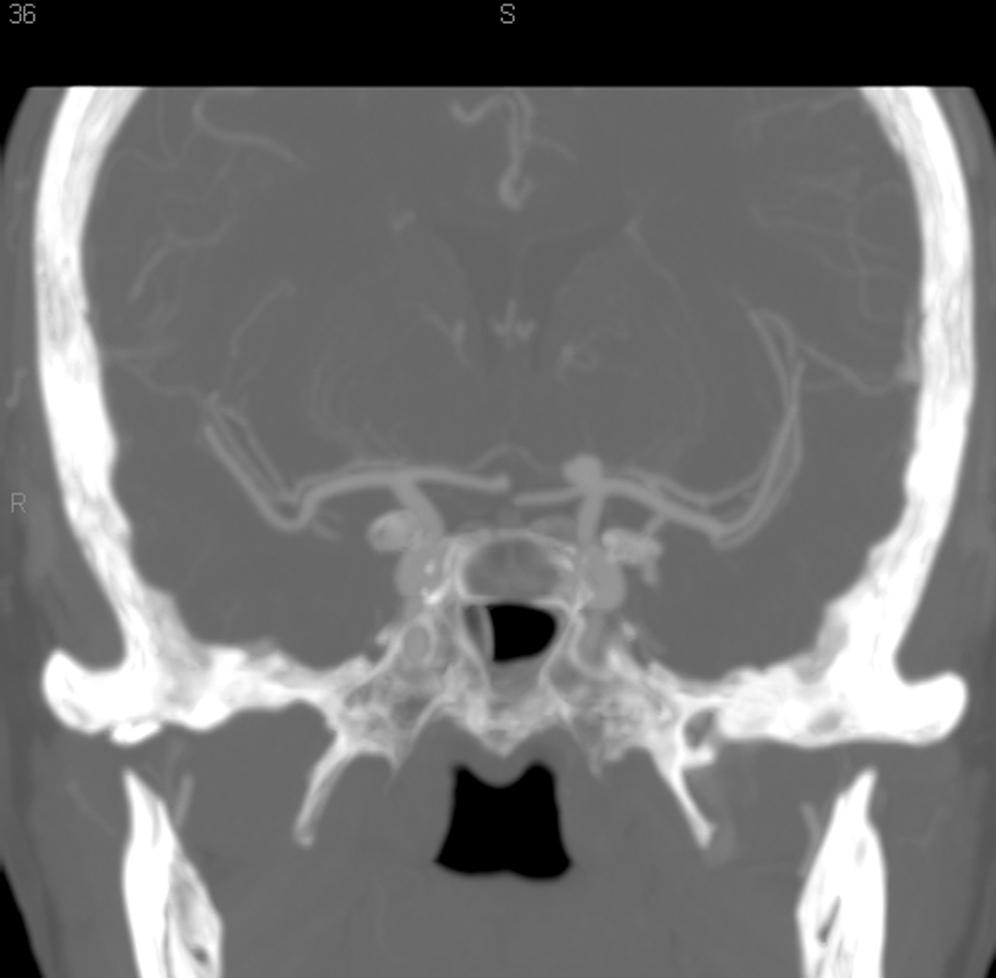
When a patient harbors multiple aneurysms, successful clipping of a contralateral aneurysm through a unilateral pterional craniotomy is facilitated by the aneurysm being located at the termination of the ICA. Perforator dissection and clip reconstruction of contralateral aneurysms at the ICA bifurcation can be accomplished through a wide arachnoid opening of the chiasmatic, carotid, and lamina terminalis cisterns, which encourages considerable relaxation of the brain.
With continued advancements in technology, as the armamentarium of microsurgical and endovascular techniques continues to grow, as care is concentrated toward specialized multidisciplinary centers, and as our understanding of the natural history of aneurysms evolves, aneurysm-specific treatment strategies may be optimized for each individual patient.
Become a Clinical Tree membership for Full access and enjoy Unlimited articles
If you are a member. Log in here